June 28, 2016 – Destruction before Creation
- At June 28, 2016
- By Cara
- In Life Stories

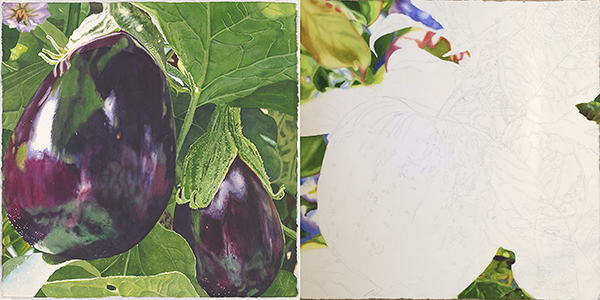
“I finished the eggplant. I called it “Global”. During the festival I started a new one – of one big apple.”
Listen to this post:
Audio PlayerThe week before last, I went to see my dear friend Julia and to meet her brand new son. Julia and I have a magical connection. Though there is a pretty big gap in our ages – I’m much closer to her mother’s age – we have a powerful bond that feels older than this lifetime. We met nine years ago, when I was just starting this odyssey of becoming a full-time artist – she worked at Light Rain and did the first reproductions of my paintings. When she told me that she was leaving her job to move to Paris to teach English to French school children, I told her how great that was for her – and then I asked if I could have her job! This began a connection that has involved being together in Paris and in New York, sharing the job at Light Rain, sharing the artist’s journey and a passion for sorting out how partnership works between the masculine and the feminine. It’s a very special friendship.
During our visit, she offered me to choose from a deck of inspiration cards written by Danielle LaPorte, a teacher/coach who offers white-hot truth in service of people living, no-kidding lives of their own creation. I love oracle cards and believe the cards we choose are not just happenstance, but have real messages for us. My card said “Destruction before Creation.” Really? This one? No perky platitude from Danielle LaPorte! But I really didn’t want that card. I’d rather have a “nice” card – not one that tells me to destroy – it sounds so violent. Julia said the card was mine to take with me. It’s not an accident I forgot it when I left. And – even without the card in-hand, the message has not left me. I’ve been asking myself: what needs to be destroyed?
I hike with Bo most mornings up a fire road that takes off from the other side of our little neighborhood. It is on private property and the owner has been pursuing developing the land. Last week, he had a bulldozer up there clearing away a whole lot of poison oak, and invasive, non-native scotch broom from the fire roads. Some of my fellow hikers are having a hard time with it. The heavy equipment scraping away the brush, has made an immediate, drastic change. I get where they are coming from and I would think that I’d be there too, but I’m actually loving it. The road had originally been carved into the hill 40 or 50 years ago, so this isn’t pristine un-touched nature – and it is now wide open again. It’s as if all the cobwebs have been cleared away. We can now see the live oak trees and the views of the hills beyond. To me it’s refreshing – even exciting. On yesterday’s hike, as I was feeling the excitement, it occurred to me that this may be the energy that can come from destruction – the wisdom in that card.
I did the San Anselmo Art and Wine festival this past weekend. Looking back to the post I wrote a year ago, the Tuesday after the same festival, I read that I was questioning whether I should still do this festival or not. Last year’s Sunday brought sweet moments of grace, including someone falling in love with “August Bounty” and taking it home, which left me thinking it was still a good thing to show up again. But this year has been altogether different – starting with the producer giving me a crappy spot, and then being downright rude to me, when I inquired about being moved to where I’d requested. I stood in the baking heat for two days, which wiped me out. On top of this, the caliber of the festival itself – so many booths of imported junk and hardly any other art – was depressing. For the first time in 10 years of doing this show, there was a lot of conversation amongst people about it. “They call it an ‘art festival’ – so, where is the actual art?” It is now really a “street fair” and my work doesn’t belong there anymore.
I’m guessing I’m not alone in this, but I need a negative experience, to realize that I’m done with something. This weekend was that for me. There have been years that I’ve done as many as seven art festivals. This year it’s just two. Next year the only thing on my radar will be the Sausalito Art Festival. But, this is how most of the people in my groups have found me, and most of those who have ended up with my art in their homes as well. So, if I don’t show my paintings at all these shows, how will we find each other? I don’t know. And I do know there will be a way.
Sometimes we just know things. After healing from the initial raw emotion of the ending of my first marriage, I don’t know why, but I knew I’d be married again. Because I knew that the kind of man I’d end up with would be a guy’s-guy, I made myself a “girl house” with white carpet and white furniture – expecting that he would likely not feel at home with this feminine décor. I have this same knowing about my art, finding its way into the world.
And in order to find this way, I see I have to stop putting energy into things that are no longer “mine” to do – such as outdoor art festivals like this one. I must destroy this part of what I do. There is a ton of energy – psychic and physical – that it takes to do these events. And what’s next won’t come through, if I’m squandering my energy where it no longer serves me. The thing is, this artwork has been put in me for what feels like a purpose. I don’t make these paintings for my own private enjoyment – these paintings are for people in the world who want and even need them. That purpose has a will, an energy, a drive, that will find a way.
It feels strange that I won’t be doing these events – there’s a voice telling me I’m slacking. What else will I do? Plus, it’s hard – most of us are wired to preserve, not destroy. But nature has her own cycles of destruction – like wild fires. A century of suppressing nature’s destructive fires, has created forests that are out of balance and when they do catch fire, the result is catastrophic.
It is just occurring to me what to do – and I’m not even sure what this means yet; but I need to create a haven, like I did with my little “girl house,” for my art life – a way station, until the next thing that I will put my bigger energies into shows up. The sound of this brings me a sweet peace. I can lead my art groups, care for my body and paint my love. Then we’ll see what arises in the space created.
The best thing about this past weekend, was talking to people who came by about their beginning or returning to paint and how I might help them. A common theme, is having the desire to paint and not doing so, because other things get in the way. With this insight, when I hear this again, I’ll offer the suggestion to see what might need to be destroyed first. There are seeds in the forest floor that need the heat of fire, in order for them to germinate. Plus, it’s a law of nature, when we make space, something comes in. But first, we do need to make space.
It is high fire season here in the west and this is a tricky metaphor right now. But, maturing and becoming more conscious, allows us to work with powerful forces in skillful ways. Seems I’m learning to embrace destruction. So, will you join me? We have our love to paint.
With my love,
Cara
June 21, 2016 – Modern art – is it love?
- At June 21, 2016
- By Cara
- In Life Stories

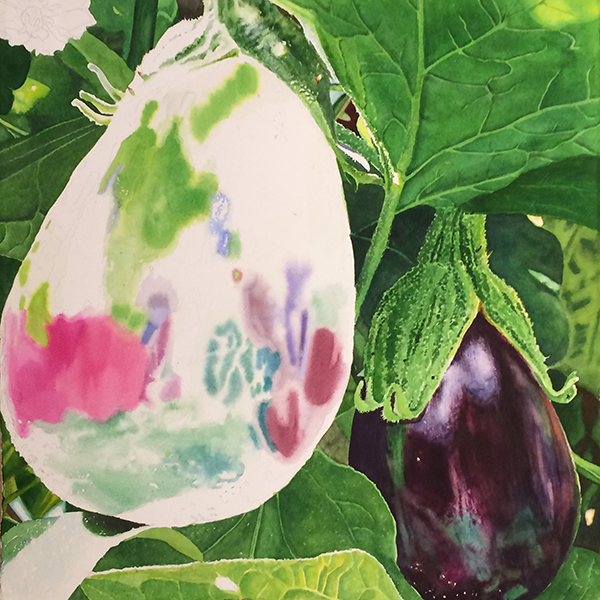
My painting in-progress. Funny how the under painting of the big eggplant is quite abstract. Reminds me what my artist friend Julia told me: it’s ALL abstract.
Listen to this post:
Audio PlayerJust after finishing last week’s post, I met my mom, my niece and her partner and went to the newly opened SF MOMA – the San Francisco Museum of Modern Art. Leigh and Lena were here from Brooklyn, and visiting our MOMA was on their not-to be missed list. So off to the city we went.
The space holding the art is wonderful: staircases that narrow (or widen, depending upon your direction) are made of beautiful blonde wood. Mid-way there is an open area with a see-through catwalk that, if you look down, would give anybody with a fear of heights, the willies. And the restrooms are an all-out, full-color experience – especially on the 2nd and 7th floors. The new museum offers plenty to captivate. Except, for me, the art collection.
We saw just about all there was to see on 6 floors of galleries. And with very few exceptions, none of it – particularly the 2D art, the paintings – inspired me. There was nothing that evoked awe or wonder, nothing I’d call luminous or particularly beautiful. Nothing that brought me into the experience of being in a body, or caused me to feel much emotion. It all brought me right into my head (huh…that’s curious… really?) and left me there.

Georgia O’Keeffe – “Black Place” – 26″ x 30″ and “Jay Defeo – “The Veronica” – 132″ x 42″ (it’s huge)
There was one Georgia O’Keeffe abstract painting, that felt like rolling hills and – as Leigh pointed out – the webs between our fingers and toes – and another by an an artist new to me, Jay Defeo, that had me think of wings and feathers. Apart from these, I can’t recall anything that seemed to be inspired by organic shapes or patterns. My experience, was there was a near dearth of gentleness, of loveliness. There was one stiff sculpture of flowers up on the top floor – but they were sort of cartoonish and odd. Besides two blow-up plastic flowers – think pool toys – there were no other flowers in the whole place. Outside the 4th or 5th floor, however, there was a beautiful living wall of various green plants.
Modern art is described with terms such as abstract and conceptual – ideas that reside in the head – in the mind. And it includes movements such as surrealist, minimalist, cubist – in which the artist has taken leave of the world as it is. So what was I expecting?
Leigh went to art school in New York for a time and Lena’s father is a modern artist – she cut her teeth on it. They seemed to love the museum. They were completely absorbed in the artwork, knew many of the artists and were happy to see their favorites. On the way home in the car, we had a discussion about modern art, abstract art, my art. Leigh offered, that my art may head in that direction as it (and I) evolve. Many artists – iconic artists like Picasso, as well as artists I’ve encountered who are close to home, have taken this journey – from representational to abstract. Is it a given? I’m not at all sure. Our discussion brought me to a familiar place, whereby those who “get” and appreciate modern art have a point of view, that those who don’t, are missing something. Leigh and Lena weren’t dismissive of me or my experience, but others are – of this response to modern art.
I went searching online and found nothing substantive in the way of a discussion, that aligned with my experience. I did find plenty of what seemed to be thoughtless dismissal of modern art, by those who say something like “I could have done that” or “a little kid could do that.” These people are called ignorant. This seems to be the extent of the conversation.
Those of us who don’t get modern art, are told we lack context and history. We must know what was happening in the world at the time. We need to understand how these artists pushed out the edge of what is considered art, from the perspective of their time. I can and do appreciate all of this. But it’s still an intellectual exercise. Chuck Close’s monumental portraits are amazing to see, but I’m not moved by them.
I met an artist when I did Art Expo in New York. She was there on her own and we were staying in the same hotel. She joined my mom and I for dinner one night. We stayed in touch for a while afterwards. She paints abstract oils and was getting quite a bit of attention and having success with her art – at the time, we last talked several years ago. We talked on about abstract vs representational art. Seems I’ve been wanting to understand the draw to abstract art for a while. What she said was “it’s about impact.” Which, I took to mean that abstract art has more impact than what I do. I didn’t get it then and I still don’t.
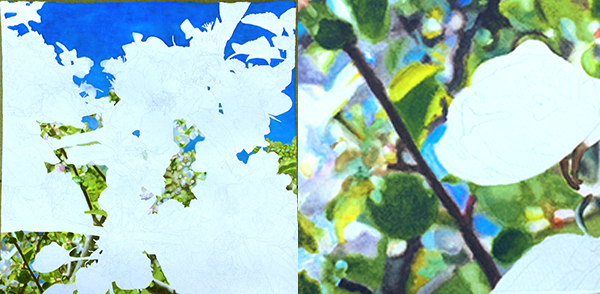
The painting I dove into Tuesday last evening.
Last Tuesday I came home to work on my own art – painting a fuzzy background of an apple orchard – as I listened to opera – specifically, the melodrama of Puccini’s music. I wanted to be brought back into my heart, to feel. I was actually hungry for it. The point of art – for me – is to delight, to inspire, to console. I’m here to express the feminine, to make a case for beauty, to bring the viewers of my art, to a precious part of themselves that they either weren’t aware of or had lost contact with. And I’m compelled to show how what is here, right now, is worth capturing and elevating by painting it. This planet and our embodied experience of being alive, is what I mean to celebrate and uphold. I do this with light and color and with objects that we are familiar with. I have had more than one person – a stranger to me – at an art festival, be brought to tears when experiencing my art. There is emotion in it.
I did find affirmation in “The Master and His Emissary – The Divided Brain and the Making of the Western World.” In his book, Iain McGilchrist talks at length about modern art. He ties modernism to the left brain and its narrow focus and tendency to disconnect and see in parts, rather than holistically. It follows then, that our left-brain dominated culture would put a high value on it.
I am not arguing against modern art or with its being highly valued. There are certainly plenty of people who appreciate it. We are a culture that reveres progress, what’s new, what’s next and it seems that this is what is, so highly valued in the serious art world. Plus, if it’s startling or even shocking, all the better. To me, it at least almost always fails to connect me to my aliveness – even more, I can find it cold and disconnected. And this is what troubles me. I believe the larger problems of our time are all related to disconnection, from the planet, from each other, from parts of ourselves.
Iain McGilchrist says this: “We confuse novelty with newness. No one ever decided not to fall in love because it’s been done before, or because its expressions are banal. They are both as old as the hills and completely fresh in every case of genuine love.” Flowers, fruit, things we love, have been painted millions of times before, but never by this artist, who is living – who is alive – in this moment. Like falling in love, painting what we love is also as old as the hills – and I say, when it is genuine, it is just as fresh.
I’m compelled to paint what I love – it’s what fuels my work, my life. I’ve recently come to know that by doing that, it goes further, by painting what I love, I paint my love. Since my sense is we all need to be surrounded by a whole lot of art-love, I’m here to support you doing so too.
So, now, go – paint your love.
Love,
Cara
June 14, 2016 – I missed a day…
- At June 14, 2016
- By Cara
- In Life Stories

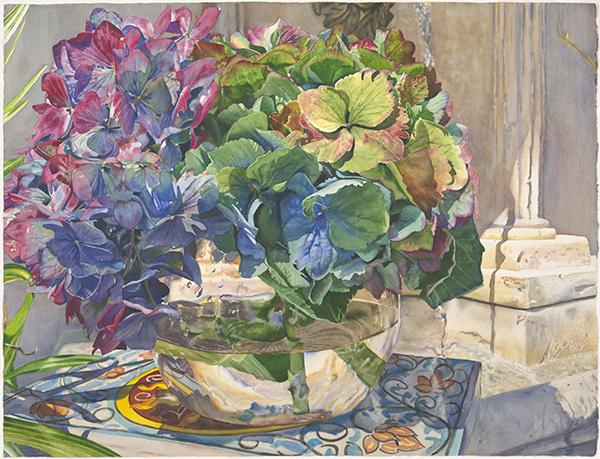
“The finished painting – I’m calling it “Offering”. Its story will appear soon in the gallery.”
Listen to this post:
Audio PlayerI woke up very early, it was still dark. Lying there awake and alert, it dawned on me that I didn’t paint yesterday. Oh, no… I checked the time – 4:04 am. My heart sunk. It was way past midnight. I couldn’t leap out of bed to paint for a few minutes, so that I could say that I did. The day was over and my streak is broken – almost 5 and a half months of painting daily, and now I won’t be able to say at the end of the year, that I painted every single day in 2016. The day went by, busied with the rest of my life and I didn’t ever make it to my paints.
To be honest, what I called painting on Sunday, was hardly worth counting either. I’d spent the day working hard out in the yard and by the time we got home from my folks for Sunday Dinner, I could hardly keep my eyes open. I painted for two or three minutes on the rain rose and crawled to bed. We had spent the day re-staining the front walk, and then I had fun painting impressions of leaves in the concrete different colors. So, though I didn’t work much on a watercolor painting (which – specifically – is my commitment), I did paint something. I had a great time using my color-mixing abilities to tint the stain intense colors of greens, golds and rusts, using watercolor pigments. But yesterday, I didn’t touch a brush for any reason. There’s no rationalizing it, I just didn’t do it.

“Some of the leaves I painted in the front patio and walk.”
The other part of it is, that after about 9 or 10 in the morning, I didn’t even think of it! To me, this is what my commitment is really about, being faithful to what is important to me – and it’s the part that has me the most disappointed. Don’t get me wrong. Action matters. Nothing happens, no paintings get painted, if we don’t actually do the work. But this commitment to paint every day, is a devotion. Painting is how I connect to myself – who I am, what I’m here to do. It is how I love, how I show my love, how I live my love. And I forgot. The sinking feeling – which is still here as I write this – shows me how connected to my heart this is.
Walking is good for sorting things out, so I did my walk with Bo, first today. As I walked, it occurred to me that my heart feels just like it does when I let Joe down. My connection to my creative life is a relationship, just as my marriage is. And then, I reminded myself that being human means not being perfect. Like some of us, I have a lot of attachment to perfection – which is often, not pretty. I recall writing to you in several posts so far this year that “I’ve not missed a day yet.” I now see the pride in making the statement. It’s tricky. It is my intention to keep my commitment, but I want to keep it for what’s behind my making it, not so that I can say I did and look good for keeping it. To be really transparent, there have been several – maybe a dozen or more days – that what I did hardly counted for much. I painted so that I could “get it in” rather than to express my devotion.
The commitment is here and it’s still having its impact. Without it, this would be a non-event. On my walk, I also reflected on the countless days before the end of 2015 that went by, when I didn’t paint and never gave it another thought. This seems to happen especially just after a big push, to get a painting done for a deadline. I had just finished “Offering” (the painting above) on Saturday morning – I guess that sometimes I just need a break. This points to another tricky part: my profession is my devotion. Sometimes it’s necessary to get into production mode – like I was last week – especially Monday and Tuesday – forcing myself to get ‘er done. Technically, that qualifies for “painting every day” but the promise to myself, is to make it devotional. During these times, it’s hard to combine the two.
I am sorry I missed a day, and I appreciate what’s come of it for me – how it has impacted me. I’m not beating myself up, but I am taking note of how readily we (at least some of us) are pulled away from what matters to us. Today, I’m recommitting anew, to paint every day the rest of the year, and I’m grateful for the way that letting something down – something that really matters – can bring me, bring us, to make a stronger, deeper commitment.
I wrote a post a couple of months ago, about fine-tuning my commitment, by actually scheduling time every day to paint – thereby protecting my devotion from being crowded out – like it was yesterday. I want to report, that I’ve done absolutely nothing towards that promise to you. In my corporate days, I was a devotee of the Franklin planner and spent every work day laying out my day. After several years of buying paper planners/calendars and using them for three or four days all year, I’ve stopped buying them. I use the calendar on my computer and phone to manage appointments, but scheduling how I spend my time around appointments, is done completely by the seat of my pants. I don’t impose structure on myself easily.
It is my desire, my intention, to head in this direction. I don’t have the answer as to how. The resistance I wrote about in that post, still lives in me. But right along side it is, my promise to honor my love – to live my devotion. I’ve heard that tension – creative tension – is how life is worked out. This, today, is mine.
In this moment, I’m also very aware of my relationship with you and how it serves me in my life and process.
With my gratitude and love,
Cara
June 7, 2016 – 10,000 Hours – Sticking with it
- At June 7, 2016
- By Cara
- In Life Stories

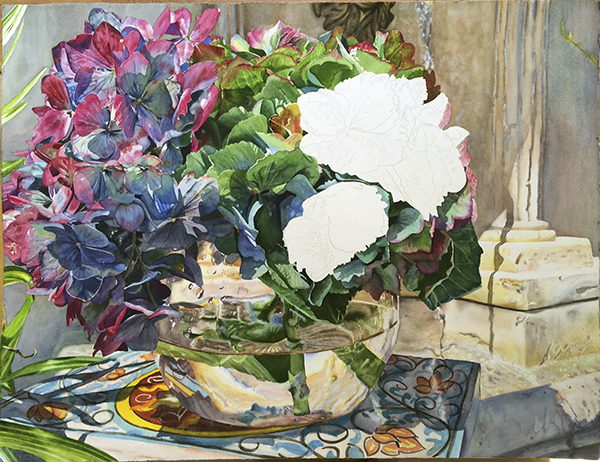
Here’s where I left it today. I’m so glad to have more time to get it done.
[Note: I will return to recording next week – I promise!]
It’s late. I’ve not started a post this late on a Tuesday since I started writing every week. I’m working against a deadline on this painting and last night I got the somewhat crazy idea that I might be able to finish it by late this afternoon- when I had an opportunity to have it captured for my reproductions. I painted until about 10:45 – which may not be all that late for some, but I’m a morning person and when I noticed I was, as I call it, “stupid painting” I knew it was time to get to bed. I was back at it at 6 this morning and painted until about 2:00 at which point I was able to make other arrangements for it to be scanned this weekend instead today. Whew!
The good news is that I made serious progress on the painting and I watched myself focus in a way that I’m not sure I have on a painting before. Not that I can remember anyway. I did stop for some exercise with Bo and to feed my brain healthy food, but I stayed with my painting like it was a patient that needed my care. I avoided putting away the dishes, I didn’t check email, I didn’t play spider solitaire like I do some evenings before painting (did I really write that!?). I painted: this petal, then one two over, then another layer on that one, soften edges on that one there. More quinacridone rose on one I painted last night – darker on the nooks and crannies on those lower blue ones. I just kept going.
After I realized I was given a reprieve on getting it done today, I picked up other balls I’d dropped (including getting to the polls to vote!). I’ve just returned from the reception for a show of Paulette Engler’s beautiful watercolors. (Check out her gorgeous website.) Paulette is a steadfast member of our Thursday group and is a prolific and dedicated painter. She calls herself addicted. When I’m going to be away she makes sure to have plenty of work drawn and ready to paint, for fear of being without. She paints just about daily at home in between Thursday sessions. And it shows. Paulette’s work has evolved markedly in the 4 ½ years she’s been painting with us. There is no substitute for time in. But, in addition to the time, she also is very intent on growing as an artist – in skill and expression.
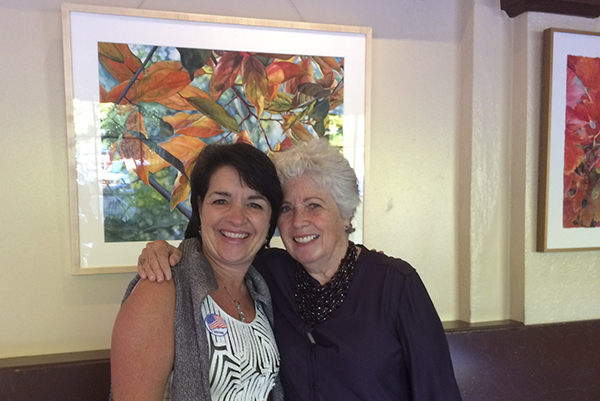
Happy evening – celebrating Paulette and her work.
Last night while I was painting I listened to an interesting interview – no, not more Krista Tippet – this time it was Jonathan Fields the host of the Good Life Project podcast. Jonathan Fields is also a wonderful collector of amazing people. This one was a conversation with Anders Ericsson, the researcher who is the source of the 10,000 hours to mastery that Malcolm Gladwell made into conventional thinking in his book “The Outliers.” It turns out that it takes more than spending a whole lot of hours to get really good at something. It matters how we spend those hours.
Anders Ericsson illuminated this by comparing playing tennis doubles for enjoyment and exercise vs. playing tennis and practicing to become a great tennis player with a coach. If we hit or serve the ball unskillfully, a coach will take us through it and point out how to do it better. But if we are playing for fun, we likely will not pay as close attention to what we did and won’t learn as quickly. If we practice our 10,000 hours with this level attention and intention we progress much more rapidly. I can’t help but think about this when looking at Paulette’s body of work, her dedication to Thursdays and the questions she asks – she doesn’t just want praise, she wants pointed feedback.
Anders Ericsson said something else that caught my ear: he sees college students, in order to decide what path to take, seeking out what their gifts might be – as if we are born with all our abilities. (I remind people I have a computer science degree and had no idea this art was in me until I started really painting.) He went so far as to say the only qualities from birth we should concern ourselves with are our physical size and shape. Regardless of how much focused practice, a short person wouldn’t make a good forward in the NBA, and a big person doesn’t make a good jockey in horse racing. Instead, he suggested we look for what we are interested in, what we want to do – and I’d say what we love. It is this desire that naturally springs from the center of us that gives us the fuel to keep going for all those hours of focused practice.
Jonathan Fields asked him what helps people keep going through what can be grueling work – all those hours of practice. His answer was: progress. We are motivated by marking our improvements over time. I so appreciate discovering information like this interview that supports what I see every week. Some might think I gush a lot over my artists’ work. But I firmly believe that every effort is worth celebrating. I’ve seen enough budding artists arrive with nearly paralyzing fear at just putting paint onto paper. And I’ve talked to others who haven’t yet made it through the door.
Intimidation is a serious hurdle. We all have a hope, if not a fully-formed vision of how we want our artwork to come out. My experience is that we are never further from that hope or vision than when we first start. There are all levels of artist in our groups, so it’s easy for a brand new painter to compare her work to that of more experienced artists and note how far she has to go. But when compared to someone who has never painted anything at all, making a whole painting, based upon an image she’s chosen, maybe even one she captured herself – of something she loves – is an enormous accomplishment. It is big progress, right from the start. And it’s also encouraging for new artists to see the early work of other artists (including me) and the progress that we’ve made in our work by putting in the time. We all start at the beginning.
This brings me to how much a supportive environment matters. To grow we have to try new things, let ourselves have new experiences. To let in what’s new we need to open ourselves – and we open much more readily when we feel safe. Then, as time goes on, we keep growing when our achievements are celebrated and our progress is noted – at least by ourselves. But, it’s my experience that the impact is considerably greater when we have a tribe to cheer us on. There were eight other artists from our groups – plus a few husbands – who were there for Paulette this evening – appreciating her accomplishment, her beautiful work and cheering her on. There is no way she’s going to stop painting anytime soon.
Whether or not any of us will spend our 10,000 hours or reach anything near mastery, all effort is worthy. Progress builds upon itself. We have paintings to show for it – our gift to the world. Plus we end up changed along the way.
Here’s to all of our creative unfolding. Now, go. Paint your love.
Cara
May 31, 2016 – Love what you love
- At May 31, 2016
- By Cara
- In Life Stories

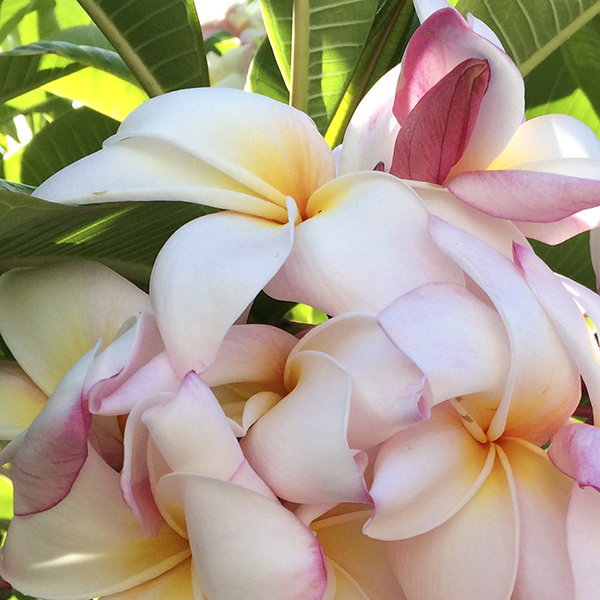
The soft animal of MY body is in plumeria heaven on Kauai.
[Note: I’ll resume recording when I’m back home from vacation.]
When I was four years old, my older brother Joe (who was 5 at the time) and I were on the Bay Area Romper Room TV show. We rode in the car over to KTVU studios in Oakland to be with Miss Nancy and the other girls and boys for our turn on the show. I don’t remember much about it, except for one somewhat traumatic experience of being re-directed – on camera – when I wasn’t doing what I was supposed to. At one point in the show we were each assigned solo activities; I was given some kind of a matching-card game. I’ve always been such a girl, and I wanted to play with the dolls that had been assigned to another little girl. She got to put on their pretty clothes and arrange them, have them talk to each other. I wanted to do that. So, being just 4 and not realizing that I really had to stay where I was, I went over to join her and play with the dolls. A camera-man then pulled me by the back of my dress back over to the cards. Oh, I was mortified! And so disappointed! I didn’t want to play with the stupid cards when there were dolls to play with!
This memory came back to me in a recent conversation pointing to me something that has always been in me. Since I was very young I have clearly known what I like – what I love – and what I don’t – and that this matters. Another bit from my past aligns with this realization. When I was planning to get married in my mid-twenties one of the things that brides did (do they still?) is register for fine china, silver flatware and crystal wine glass patterns. I went to all the department stores, including Gumps in San Francisco, searching for exactly what I wanted. If a store didn’t have anything that I wanted to set my table with for the rest of my life, I moved on. I didn’t accept their selection of patterns as all my options. I liked what I liked and wasn’t willing to settle!
As I looked at this, I remarked at the line from Mary Oliver’s poem “Wild Geese” (hear her read her poem here) that is on the front page of my website and in my artist statement: You only have to let the soft animal of your body love what it loves. Yes. This. It is what I believe, deeply, fully, completely. And I’m realizing this is what I’m here to teach and even – dare I say? – preach. Mary Oliver’s inspired words – the soft animal of your body – make it visceral and intimate. Coming to know what the soft animal of our bodies love isn’t an intellectual exercise – it’s not something we figure out. Either we experience it in the moment or when we don’t, it’s something to discover, or rather uncover.
What allures us, what we love, is intertwined with who we are at the deepest levels. And the increasing permission, the expanding freedom to live accordingly is aligned with evolution – both in each of our lives and in our culture. I have far more permission to love what I love in my middle age than I did, say when I was a teenager and was so concerned about being accepted and included. The recent expansion of the law to include same-sex marriage – granting the freedom to openly love and build a life with the person who we love, regardless of their gender and ours – shows how our culture is evolving in this direction too.
We don’t consciously choose who and what we love. Who and what we love is a given. I believe it is given to us. I’d go so far as to say that what we love chooses us. And when we live with loving what we love at the center of our lives, making it visible, loving what we love becomes who we are to others. Quite often I get messages or Facebook posts from people with pictures of beautiful flowers along with messages telling me that when they saw that flower they thought of me. Me! By loving what I love (painting flowers illuminated in sunlight that I’m so drawn to) I’ve become a “beautiful flower” person to them. The same goes for Paris. I am a “Paris person” to those around me. My hubby is a pilot, so he’s an “aviation person.” My brother Joe is a “tropical fish” person – he has an eight foot long salt-water tropical reef tank in his living room that he tends to. There are several people in my life who are “dog people.” When we love what we love, whatever is our “thing” becomes who we are.
I don’t mean to imply that we should love everything. If we were drawn to everything equally, we’d not have the contrast we need to see what we do love. And – there are things we are ambivalent about too – I sure don’t have strong preferences for every aspect of my existence. But knowing what we love and letting ourselves love it where it matters most to us makes the difference between a life worth living – and not.
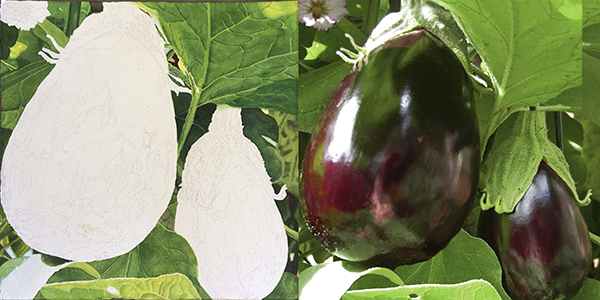
I’m painting these eggplants for our “shiny things” Special Saturday this weekend. But somehow, it’s not doing it for me in Kauai.
I’ve been here on Kauai for two weeks. The paintings I brought along with me on this trip have just not grabbed me. I so love to paint here in the soft, moist air and several of the days here I’ve had to make myself sit down to paint – to keep my commitment to paint every day. The experience of painting something that does “do it” for me, is altogether different. I can’t wait to get back to it, I have energy for it. I’ll get there with the painting I have underway, but in the moment it’s hard to be excited about it. The good thing about this experience is that I’m living right now the not-loving what I’m doing – the contrast is striking.
All of this shows me why I was reluctant to teach at first – my fear and reluctance served me. I didn’t know how to teach in a way that would honor my desire to have people love what they love. The only workshop and class formats that I knew of were those where the teacher assigned something to paint – either everyone painted the same image or a subject chosen by the teacher – including a dead fish sitting in the middle of the table. I think this is why I’m largely self-taught – life didn’t put a teacher in front of me that provided exactly the kind of instruction and environment that supported me to paint what I loved. I needed to figure it out for myself, so I could offer it to others.
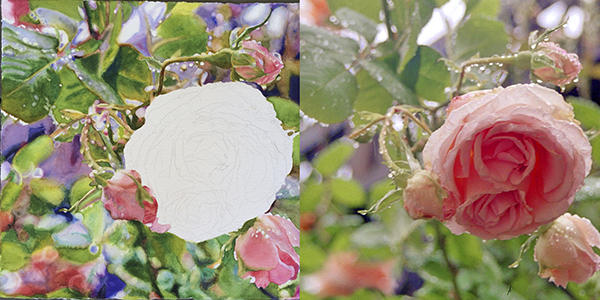
I’m glad to have this little painting with me – at least I have flowers to paint here.
Because of this I am not the teacher for everyone. When a new artist/student comes to paint in one of my groups, if they don’t know what they want to paint, I ask questions, I offer a computer to look through photos, but I don’t give any assignments. That doesn’t work for everyone, so it’s really good there are teachers who offer more structure. For me, it’s worth waiting for a flicker of inspiration to emerge. In doing so, it invites the soft animal of your body to share what it loves. The art that then comes of you is personal, it’s yours. My hope is that the flicker will become a flame of inspiration, a hunger even, to share with the world what you love.
There is a genius in you – something you that said “I want to learn to paint” that is connected to something deeper than acquiring paint-handling skills. I’ve never been more clear or more certain that I’m here to create the environment and provide the support and encouragement for you to paint what you love, live what you love, love what you love. I love the book “The War of Art” by Steven Pressfield. The last section of this book is laced with this very message. These are the last lines from the book: “Creative work is not a selfish act or a bid for attention on the part of the actor. It’s a gift to the world and every being in it. Don’t cheat us of your contribution. Give us what you’ve got.”
It’s worth repeating: let yourself love what you love – and then, give us what you’ve got.
Love,
Cara
May 24, 2016 – Healing places, healing spaces
- At May 24, 2016
- By Cara
- In Life Stories

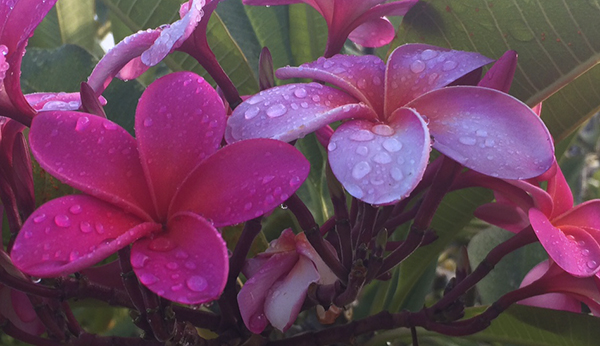
“A glimpse from the plumeria tree that I see when I’m painting here.
[Note: I’ll resume recording when I’m back home from vacation – at the latest.]
Joe and I are over on the island of Kauai. This year I’m here for 15 days – a good long time (by most of our standards). Even though we are here to rest, and painting is work for me, I always paint quite a bit over here. It’s a real treat to paint in the moist air – it just works differently. Though the paper feels dry to the touch, there is a softness about it that makes for easier blending. And because it’s so warm, it dries pretty quickly too. A couple of days ago, as I started to paint on the covered front porch, of the little place we are staying in, I had an inkling to look for something to listen to, as I did. I took a peek at the On Being site, and stumbled upon an episode that seemed perfect. Krista Tippet interviewed Esther Sternberg, an immunologist, who is looking at the impact that our physical surroundings have, on healing our bodies and has written a book called, “The Science of Healing Places.”
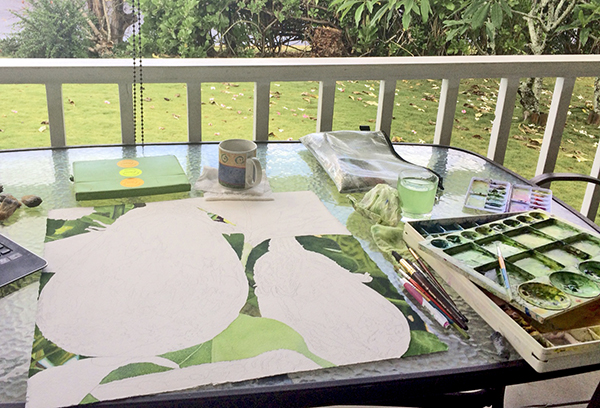
“My painting of big, shiny eggplants beginning to come through.
If ever there is an environment that I experience as healing, it’s this beautiful island. The first thing we hear every morning, when opening the French doors, is the sound of the all the birds – many of them quite distinct – Hawaii bird sounds. There’s almost always a breeze moving the soft, balmy air over our skin. Plants seem to grow before our eyes, the life-force is so unleashed here. The owners of the little house where we are staying, have some tomato plants, in some big pots along the driveway. Joe swears they’ve grown a foot since he arrived (a week before me). The smells and tastes are amazing too – the fruit and the flowers are exotic and intoxicating even, so not like home.
And then don’t get me started on the colors! There are, of course, all the greens and the vibrant colors of the flowers, but even just the ocean here is more colorful than at home, it reflects so many hues of blue and turquoise. Floating around in it, as we are every day, is its own kind of heaven. It’s just the right temperature and so salty, that we stay afloat without a lot of effort. We also seem more connected to the rhythms of nature. We hardly ever talk about going to see a sunset at home. But here, every evening we are tuned in to when the sun is going down, often making a trip just to go watch it, as it descends below the horizon. This is an amazing place, that brings us to a whole other experience of being.
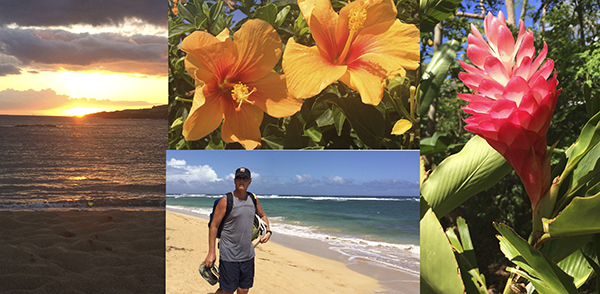
“Kauai color…”
Krista Tippet asked Esther Sternberg, about her definition of the word “healing.” Calling it a verb, she described healing as a movement that takes us from illness to health, restoring us to balance. Life is a constant barrage of injury, illness, cell oxidation that would quickly lead us to our death without healing, to return the cells of our bodies to their proper function. When Joe was having chemotherapy for lymphoma, the drugs zapped his immune system so badly, that a tiny little red spot around a hair follicle on his thigh the next day, became a red infection the size of a silver dollar. It was scary to see how fast bacteria can eat at us, without our capacity to heal ourselves.
Intuitively, it seems obvious that being surrounded by beauty and nature, seeing color and light, being inspired by what we see and hear, would aid in our healing. It’s well known, well studied, and well documented how stress causes disease and inhibits healing. But Esther Sternberg is pointing to her findings – scientific studies – of the opposite – how certain physical surroundings, cause measureable differences in recovery from surgery and illness, and how architects and planners are focusing on building hospitals, work places, urban development even, that support our healing.
There is another aspect of what I heard, that I’m tuning into. The conversation touched a couple of times, upon how cathedrals, with their soaring spaces that are often filled with the spectacle of sunlight, shining through colorful stained-glass and how they inspire and uplift us, causing a healing effect. Not only are we artists appreciators of color and light, but we create these experiences for others. Hearing this was a welcome affirmation of the impact of our work. So often, people evaluate artwork for how it works in their décor – which I completely understand. But it’s not nearly as meaningful as the idea, that we are potentially aiding in someone’s healing with our creations. Looking at what I paint, anyone can see how drawn I am, in particular, to color and light. I’ve said that if I didn’t paint watercolor, I’d want to work in stained glass. Color and light are the whole point for me.
I’m so very grateful that I have the great fortune, to be able to come visit this particular piece of paradise quite often – we come here pretty much once a year, sometimes twice. And a week from tomorrow, we’ll be on a plane to come home. Though where we live is a pretty nice place, it’s not Kauai and the experience of being here, will be in our memories. Esther Sternberg ends her book, by talking about how we can create healing places, through our minds and our memories. Though the places humans build – healing-oriented hospitals, public gardens, beautiful spaces in our homes, when we recall experiences of being in places like where I am now, our brains are flooded with positive emotions, which support our healing.
I have to wonder if this isn’t, in part, what we are up to with the art we make. My sense is that beauty, flowers, the color and light that many of us are drawn to paint, are in partnership with us, to create and spread healing experiences for others. Last summer, we had an exhibit of 99 watercolors of flowers in the corridors of the exhibit hall, at the Marin Civic Center. The staff that worked in the offices adjacent, said that the whole building felt different with our art there; they said it was both calming and inspiring. Seems like healing energy to me.
There is another healing going on here too. Having art become central to our lives, heals us. I’ve seen this in my own life, as well as some who have come to paint with me. Not only are we healing ourselves, but with our use of color and light, we create vignettes that spread healing into the world. How great is that?
With my wish, that this helps bring a bit of the healing I’m experiencing to you.
Aloha,
Cara
May 17, 2016 – In the Eye of the Human Hurricane
- At May 17, 2016
- By Cara
- In Life Stories

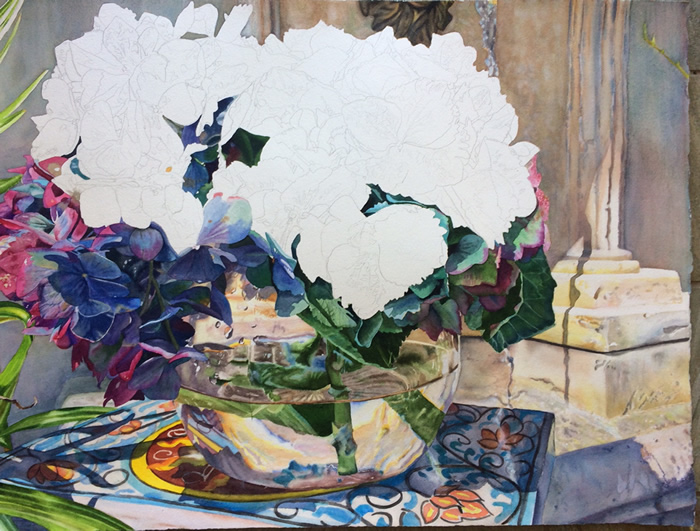
“I’m in the eye of the hurricane with this painting – it’s home while I’m away for two weeks! I’ll get back to the flurry of all these hydrangea petals in June.”
[Note: I’m travelling today. I’ll resume recording when I’m back home from vacation – at the latest.]
On Friday I had a long talk with someone who is very special to me, who is living through a very difficult time in her life – one that is asking an enormous amount of her. She said it’s the hardest time she’s ever been through. Part of what we shared, was what comes of living through hard times. It’s a great paradox: we never want to endure hard times, nor wish it for others – anywhere, but it is what makes us us. Or it can be – depending upon how we meet it. Good times are wonderful – falling in love, having great success, visiting beautiful places, being surrounded by wonderful people, enjoying robust health – or just feeling at home in our lives, as things go along. Good times are necessary to bring encouragement, rest and to refuel us. But from what I’ve seen of life, it’s the hard times that forge us – evolve us. They make us stronger, more resilient, more creative – and more human.
It’s a strange setup, that what we want to avoid, is also the thing that sculpts us into who we are and brings out our humanity. My attention is always captured by examples and stories that illustrate this. I heard an interview of a man who lived through WWII in London, the siege, little food, loss of loved ones, loss of a normal life. And he said it was the best of times. People helped each other out, made do with less, celebrated more, took nothing for granted. Joe and I had a trip planned to Italy on September 14, 2001 – just three days after the attacks in New York and Washington. I spoke over the phone to someone who ran a small agritourismo, in a tiny town outside of Florence, asking to cancel our reservation. She was kind and concerned and said, “of course” and refunded all our money without question. This Italian woman and I had no idea who the other was a few days before, but because of the horrible circumstances, we were no longer strangers. My dad was diagnosed with prostate cancer in 2000. Without speaking of it with each other, or planning it, all four of us, my brothers and I, showed up that evening to circle the wagons and be with Mom and Dad. Hardship shows us our love of each other – it connects us.
If you think about it, if we had no hardship, we’d not learn anything new, not appreciate all we have, not have a sense of our own contribution, the difference we make, and we’d not need each other. Though it’s our nature to avoid it, escape it, numb ourselves or just complain, we must meet hardship – we must really live it, for it to have its way with us. And I believe that without some source of love and support, this is just about impossible. My friend shared with me how valuable it is to her, to have people hear her. She needs for someone to simply take in what life is like for her – allow her to share deep, painful feelings and experiences – without trying to fix things or console her – or to show her the “bright side.” What helps the most she said, is to have someone say “oh, how awful this must be – I’m so sorry.” Being witnessed, is a way out of the loneliness of our suffering, and it makes our experience real. It helps us find a way to hold what we are dealing with differently; it has us realize that though we hurt, some part of us is fully whole. My friend said, “this is so hard… and I am fine.”
I know that in my life, the support and witness I’ve had during my seasons of struggle, have helped me see my way through to a new level of capacity and awareness. I have (and have had) lots of people in my life who provide this kind of witness – therapists, coaches, ministers. I’ve heard them say how their own lives, the hardship they have had to endure, has provided them with the experiences necessary to serve others. We can be taught about human behavior patterns and faith traditions, but we can’t get a degree in compassion and connection. If we’ve not ever experienced grief, we can’t be with someone who is currently experiencing it in the same powerful, real way.
Not to make us mechanistic, but it occurs to me that we – specifically our hearts – are sort of like processors of hardship. In goes human experience – human suffering, challenges. When met, when felt, truly, deeply, it transforms – out comes compassion, connection and capacity for perspective – as well as creative solutions to our problems. It thereby leaves us changed, stronger, with greater capacity to respond to difficulty down the road. I wrote a post several weeks ago, where I said those who have the capacity for their own suffering, have fully “digested” their pain. This is what I’m talking about here. It’s like the Buddhist practice called tonglen. I may not have this exactly right, but my understanding of it (from a book I read years ago by Pema Chodron) is that we breathe in suffering and breathe out love, thereby transforming dark into light within our own beings, within our hearts.
I’m up in a plane as I write this – on the way to Kauai – to meet my sweetie, who is already there. As I look down, I see layers of clouds and the blue ocean below them. Fortunately (especially because I’m a bit of scardy-cat flyer) the Pacific Ocean is living up to its name, and we are floating smoothly above the earth. Maybe because I’m suspended in our atmosphere, but the idea of a hurricane has come to me. Gale force winds swiping across the land, in the center is the eye, a place of relative calm. Though this is a rather violent metaphor, I think that when life is tossing us about, we can find ourselves in the center of the storm, where everything doesn’t hit us with such intensity. I wonder if this isn’t where my friend finds herself, when she realizes that, despite all that is swirling around her, tossing her life about, she is still ok.
I almost always have the intention in these posts, to bring what I’m seeing about life to art-making (or visa-versa). Art making certainly isn’t as hard as the greatest hardships in our lives, but the analogy applies, nevertheless. Learning to work with watercolor is hard. Learning to see – really see – what’s there and training your color eye, can be hard too, if you’re not amongst the few, who have been bestowed these abilities from birth. And there isn’t any way to learn, to gain the abilities, these skills without actually doing them. We must sit down, dip the brush in water, in paint and put it to the paper ourselves. In this way, it is a solo endeavor; anyone else’s hand on the brush, and we miss out on the benefit. And the bearing witness part applies too; it is always my aim to minimize the discomfort, by normalizing the struggle and offering pointers along the way.
I so don’t mean to trivialize great suffering, by comparing it to painting. But there is a spectrum, a range of degree of intensity in everything. And fortunately for most of us, our suffering is more frequently small-scale, than hurricane-force. But maybe if we practice finding the eye in the smaller storms, like when we are learning to paint, finding it when the big stuff comes, we’ll be better prepared. Then when the storm passes, and we can rest, we reform our lives from a new place, with a new perspective. This is my great hope anyway.
With my love,
Cara
May 10, 2016 – Holding Space for HOPE
- At May 10, 2016
- By Cara
- In Life Stories

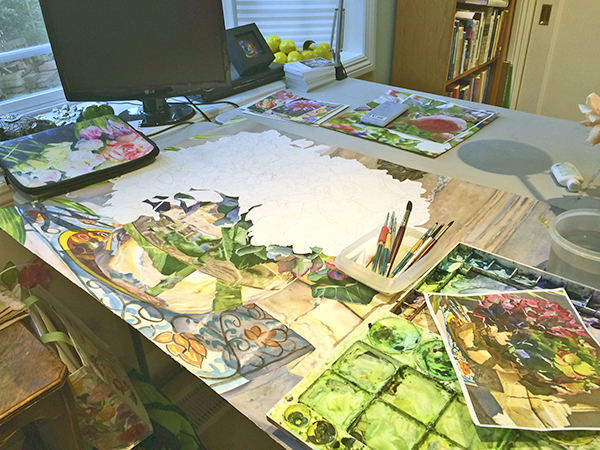
The physical space that holds me while I do most of my painting. My somewhat messy studio!
Listen to this post:
Audio PlayerMy mentor and coach Lissa Boles, shared a link to a blog post with my coaching group, suggesting it was a useful read. The post is written by another coach/writer/speaker, Heather Plett. The topic of her post – which evidently has gone viral, having been translated into several languages – is “holding space,” which she describes, as something we do for others – we hold space for others. Here’s the description from her post: “[Holding space for another] means that we are willing to walk alongside another person in whatever journey they’re on without judging them, making them feel inadequate, trying to fix them, or trying to impact the outcome. When we hold space for other people, we open our hearts, offer unconditional support, and let go of judgement and control.”
The post goes on to provide eight tips on holding space well. As soon as I read this, something clicked for me – this is it! This describes the environment I’m fostering in our watercolor groups! I’ve had the sense, that what’s going on in our groups is much more – it’s richer, deeper and more subtle than just imparting, teaching and practicing watercolor skills, learning to see and learning about color. Our groups are a place, where who we are as artists and who we are becoming as artists – and people – are safely held. We are held in a special “container” that encourages the emergence of our artwork from us, as well as that of our evolving selves. This may sound lofty – but I know it to be true. I believe that when something strikes a chord, as this post has for me, there is truth to it. Like recognizes like. It is the God in us that sees God.
So, what are we holding in this space? It seems to me, that when we need space held for us, it’s mostly when we are experiencing something that is hard, painful, challenging in some way. When I think about what this is in our group sessions, this list came up:
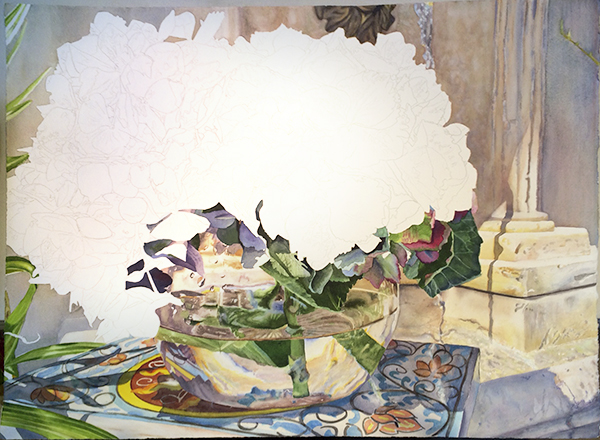
Here’s where my painting is this morning – I’m at last on the hydrangeas.
- When an artist is looking at a complex reference image, or a complex part of it, and is overwhelmed with how in the world am I going to paint that?
- When an artist is really frustrated at how elusive getting it just right is.
- When an artist has painted something that looks terrible to her eye and she fears she’s just ruined her painting.
- When an artist is sick of her painting because it’s taking so long to paint, asking herself will I ever be done with this?
- When a new artist looks at the work of another in the group, who likely has been painting for years and years, and wonders if she’ll ever be able to paint anything like that.
- When an artist feels empty of ideas and unsure about where to go next.
- When an artist is afraid to take on a new project, for fear that she’s not up to it, or because it might not be received as she’d hoped.
- When an artist’s work isn’t accepted in a show.
- And then there’s the rest of our lives: illnesses, injuries, surgeries, deaths, worries about loved ones. There’s room for all aspects of us – because we have no choice, but to bring our whole selves with us when we gather to paint.
And sometimes we need to hold space for each other’s celebrations too. It may be that there isn’t anyone else in our life, who understands how hard that painting was for us, how faithfully we worked on it. It is not uncommon for well-meaning spouses and other family members, to be critical of our work in ways that aren’t in the realm of “holding space.”
At the end of Heather Plett’s post, are links to follow-on posts that I found worthwhile as well. Two in particular: 1 – we need to hold space for ourselves first. Yes, I know! There have been a few times when I’ve felt stretched too thin, and I’ve been a bit short in what I said – away went my capacity to hold space. I’m not expecting perfection from myself, just noticing the result of not allowing for my own needs and limited capacities. And 2 – sometimes holding space, looks like doing nothing. Just reading the title of this one, was enough to assuage the part of me that seems to always worry, that I should be providing more substance or more something – even this part of me isn’t sure exactly what – to our group sessions.
Art classes and art groups – in my mind – are ideal places to find this kind of holding space – in fact, arts communities are some of the places that Heather Plett wrote, that her post has found its way into. Making art can cause us to feel quite vulnerable; having a safe container can mean a sticking with it or not. But it’s certainly not universal. I’ve not taken all that many art workshops and I have not been part of any on-going groups, other than ours. But I can say that in those I have, by in large, I didn’t feel like the environment particularly held space for my art and me. Mostly it was neutral – which left me feeling out on my own with my inner process. But I also have experienced what it was like, to have whatever the opposite is – where I felt distinctly unsafe and un-held, as a fledgling artist. It’s a world of difference, from when we are.
I’m blessed to have places where I can count on space being held for me – especially in the arena of coaching and counseling. But I also know, that the artists who have been drawn to join our groups, hold space for my emergence as a teacher and guide. Our holding space for each other is quite mutual. Without having the distinction or the capacity to articulate it, I see that (after a few experiences of the opposite early in life) I’ve spent a lot of my life unconsciously seeking out places, where space is held for me. My instinct tells me, this has contributed to my capacity to hold it for others.
Looking at my own experience of being held, as well as that of holding others, holding space for each other seems world-changing. What if we held space for our mates, our children, our parents, our friends, our workmates, allowing them their own journeys – at their own pace and rhythm? I know a lot of this happens already, or we’d not have the cohesiveness in the world that we do, but I’m guessing there’s room for more. In another of the follow-on posts, Heather Plett shares how her daughter found her way through troubling times, by writing on the walls of her room. One of the things she wrote, I’d not seen before: HOPE: Hold On, Pain Ends. This is exactly what we transmit, what we intend, but leave unsaid when we hold space for each other. There’s another unexpected place, Heather Plett’s post has found its way – the US Marine Corps. Knowing there are soldiers who are interested in holding space for each other, gives me hope – which helps me hold space for our world – just as it is.
With my love,
Cara
May 3, 2016 – Seeing with the eyes of love
- At May 3, 2016
- By Cara
- In Life Stories

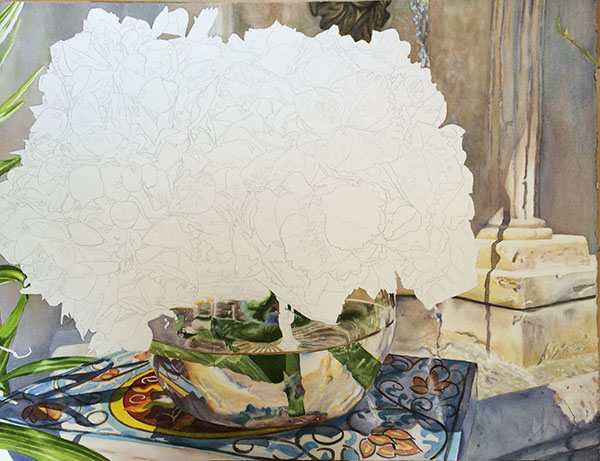
I’ve decided that trying to get the huge blossom and bee painting done my mid-June is crazy with all else going on, so with the eyes of my heart, I’ve returned to this one. And, I’m very happy to be back with it.
Listen to this post:
Audio Player“Ding!” went my phone Sunday morning. It was a text message from my neighbor and friend Jackie, asking me if I wanted to join her for a hike up the hill. It has been weeks since we’ve seen each other. I texted back “Sure!” I put my shoes on and trotted over, since her house is closer to where we start our hike. When I got there, she took me through to the backyard to share with me, her plans and challenges with re-doing their backyard to make it a fun and beautiful space, she and her family would use. Standing on her deck looking down at the level land, in full morning sun, I was envious. Our house sits between a huge oak tree – the subject of my very first post – and a near-vertical wall of rock,that is quite close to the back of the house. And because this wall of rock is at the bottom of a very big hill on our eastern side, we get zero sun until very late in the morning – not until mid-day in the winter. I would just love to have her full morning sun. Then, we did our hike up the hill with her sweet little dog, Mimi. We were having such a good time catching up, that when we got back to her house, she said she’d head my way so we could keep talking. She ended up walking with me all the way back to our house. She’d not been here before, so I gave her a tour around and through the house and yard.
For the past few years, Joe and I have been toying with the idea of finding a new house – largely so we could have some morning sun. I can’t imagine living the rest of my life, without sun streaming in my home until almost lunchtime. Just recently, we’ve decided to take on some projects to make sure our place looks its best – in case we do decide to put it on the market, we’ll be ready. And if not, we’ll enjoy a more usable and beautiful house and yard. As I showed Jackie around our place, I was telling her what we’d planned to do. What I realized I was doing, was telling her what I saw was wrong and ugly. What she saw, was how substantial, well-designed and solid our house is. We have beautiful hardwood floors that come from native tan oak trees. I love these floors and would miss them when we don’t live here anymore. But what I did point out, was one spot where there has been a lot of wear and is in need of re-finishing. Outside, I see the bare dirt where we used to have a struggling lawn and with the drought, we let it completely go. She saw the rose bushes and the really cool looking native rock.
Seeing our house through Jackie’s eyes, opened mine. She’d more recently seen a whole lot of houses, looking for the one they live in. Jackie’s reaction to our house in comparison to so many others, reminded me that we do have a really nice place. We have re-built our house with new everything – windows, doors, trims, siding, roof, bathrooms, kitchen, electrical, plumbing and heating systems – even a whole new clean and finished garage – and none of it is older, than 15 years. All the work we’ve done to this place makes it really solid, really functional and really beautiful. But, I’ve been focusing on the spots on the carpets, the walls needing a coat of paint, the planters that have been without plants – since I gave up on this yard, and started creating a garden in my studio, with watercolor.
I’ve been thinking about how this is. How is it that I can be so blinded by the little things, that I’ve forgotten how great all the big things are? The saying came to mind: familiarity breeds contempt. Though I’d not say I have contempt for our house – (however irrational, sometimes I do have contempt for that huge hill blocking our morning sun!) – but, there’s something to this adage that relates. When we are close to something for a sustained period of time, we can get pretty critical of it, and it can become pretty irritating. I see this in relationships – people who have been married a long time can get cranky with each other. And of course, I see it in how I relate to myself and my art.
There’s nothing I am closer to on a regular basis than myself, and I have to wonder if this is related to my being a relentless self-improver. The current vein of exploration in my path of evolution, is to understand the value of what I bring – specifically as an artist and a teacher. What makes what I offer special, unique to me? Seeing our house through Jackie’s eyes, makes me wonder if I’m having a hard time seeing it, because I’m so familiar with myself. I focus on all the little things that aren’t quite “right”, which keeps me from seeing the big things, that others seem to so appreciate.
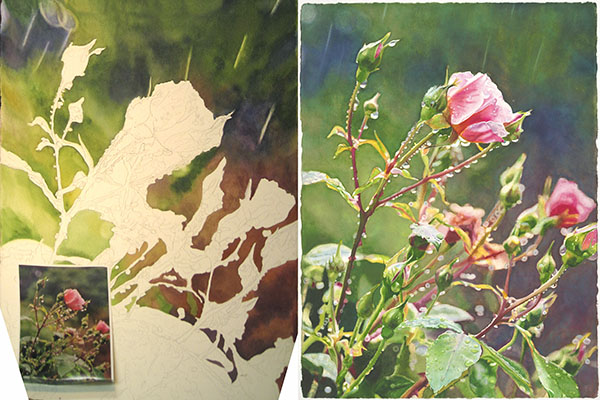
My painting Raindance both at the place where it put it down, and all finished.
I see how familiarity breeds contempt, (or at least distaste) in our artwork too. There are paintings of mine that, while working on them, have fallen completely flat – the excitement that I always start a piece with – evaporated when what I’ve done, is really unpleasing to me. Sometimes I’ve pushed through – and by doing so have learned a lot. But there have been a few in recent years that I’ve set aside, because I can hardly stand to look at them – only to come back to them and, when finished, have them be very well received. I’m not alone here. There is hardly a weekly group session that goes by, where I don’t hear someone express something negative about their artwork. But I’ve come to believe that it’s just part of the deal. I’ve said this before: we have the unenviable job, of painting our paintings. Our view is zoomed way in, intimate with each brush stroke and wash. Sometimes what we need to do is put our paintings aside, and sometimes we need – like I did with Jackie and our house – the view from fresh eyes. We provide these fresh eyes to each other in our groups.
Today, I’m wondering if we can’t cultivate these fresh eyes for ourselves, for our artwork, for those closest to us in our lives – those we are most apt to get irritated with. In the poetry of the Sufi mystic, Rumi “the Beloved” is a major theme – the divine one who loves us unconditionally. I’ve not read all that much Rumi poetry, but enough to know, that what I want to cultivate is seeing as the Beloved does – through the eyes of love. I found this line from Rumi this morning: The light which shines in the eye, is really the light of the heart. What I want is to receive what comes through my eyes, not just in my mind – where criticism lives – but in my heart, where honor and appreciation live.
I say not “just in my mind” deliberately. We need our minds to help us determine, whether we are on track – with our art, with our relationships, even with ourselves. But if the comparing, critical eye is all we have, we miss so much. We can’t see the soul that emanates from whatever it is we are seeing. Apart from during the glow of newness, seeing with our hearts can sometimes be a challenge. We can refresh our vision, by either taking a break or seeing through the fresh eyes of another. And sometimes we can just by the virtue of grace.
I’m all about connection. And seeing only with a critical eye is disconnecting. To stay engaged with all aspects of our lives – our creations, other people and ourselves, we need to see with both our evaluating minds, and our appreciating hearts. All the reminder I need, to is simply recall being on the receiving end of that kind of heart-seeing – being regarded with the eyes of love. Regardless of what’s being said to me, I know I’m held. This is who I want to be – for my home, for my husband and family, for my artwork, and for those who come paint with me.
Seeing you with the eyes of love,
Cara
April 26, 2016 – Why paint?
- At April 26, 2016
- By Cara
- In Life Stories

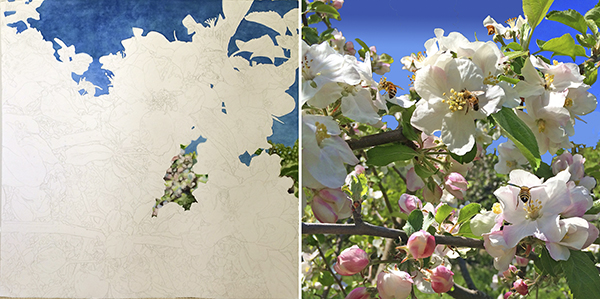
The new painting and the image I’m painting from
Listen to this post:
Audio PlayerI’ve just started a new big painting. When my coaching sister Susan, gave Happy a home up in the wild grasslands of Canada last year, we decided it was easier to ship it unframed. So, for almost a year, there’s been a beautiful frame for a 40” square painting, sitting up in my hubby’s workshop. It’s been begging for a new painting, so that it can be out of potential harm’s way – and up on a wall somewhere. I’ve spent a lot of time figuring out what that might be. Not every image calls to be made into a painting this big.
What has come up, is another with blossoms and blue sky – following in Happy’s vein. The trip to Filoli with Sue and Lenore, gave me the images to draw from. This one is a combination of two branches, one of which had a bee on it. But it needed more. So I’m doing something I’ve not really done before – I’m “faking it”, by bringing in two other bees from other images I took. Yes, it would have been amazing if I had been able to capture this whole thing, just like this – the two branches and the three bees. But I didn’t. And I want the painting to really come alive, like I was, when I was there with Sue on that perfect spring day, obsessing about getting the perfect apple blossom pictures to paint from.
When I’m looking through a bunch of images I’ve taken, most of them don’t “work.” I look for a certain something in a composition – the light, the arrangement of the flowers or fruit – whatever the subject is – it has to meet me. There is an instrument in the center of my chest that feels it. It is a “yes” – a spark of energy, that expands when I see the one to paint. Sometimes it’s elusive – I want to paint it, but am not sure. So, then I project it amongst several other images at the size I might paint them. I could get the internal go-ahead at this point. But if there’s something in me that is trying to force it, I compare it in my mind to what I’ve already painted. If it doesn’t hold its own amongst the rest of my work, I keep looking.
Those of you who’ve painted with me know, that I paint the furthest away to the closest up. This means I’d paint the sky and the out of focus background first, then the branches and leaves, before painting the in-focus blossoms. I save the focal point for last – in this one, it’s the bees. I do this for two reasons – one is to keep my motivation going. I paint the part I’m least interested in or I find the hardest first, saving my favorite part for last. The other is, if, when painting the background, I, paint over the main focus by accident, it’s much easier to clean it up before I’ve painted – say, the subtle shading of a white petal. I’d have to fix what I’d already painted.
The actual painting process of this one, is off to a bit of a bumpy start. The blue sky looks blotchy to me – but I’m living with it and am moving on. I’m now into the hardest part – the fuzzy background. There is a lot of it in this one. As much as I’ve been enjoying the actual painting, it’s taking a very long time! Just that little section – roughly 6”x7” or so – has taken me 4 painting sessions (between 1-2 hours each) to paint. I think I’m going to need to shift my process and paint some of the blossom petals – with their larger expanses – or I’ll make myself crazy, painting fuzzy circles for days and days. I was hoping to get this finished by mid-June, to enter in the Marin County Fair. We shall see!
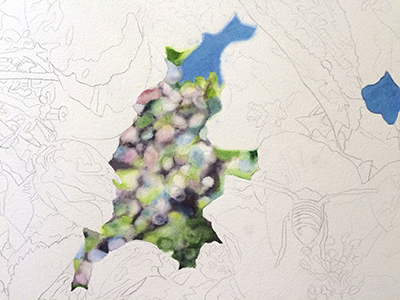
Here’s a closer view of the start of the background
While I’ve been painting, I’m continuing to accompany myself, with more Krista Tippett. Over the weekend, I heard “Einstein’s God.” Albert Einstein was an incredible man. Beyond his forwarding and expanding our understanding of the nature of the universe, he had a wise and compassionate heart. I learned he loved music, and took his violin wherever he went. He said something about the place of art in our spiritual lives,that had me go back and re-listen last night, so I could transcribe it for you. He said that his God was not a personal God, but a cosmic God, that gives him a feeling of “nobility and marvelous order which are revealed in nature and in the world of thought. Individual existence strikes [us] as a sort of prison and [we want] to experience the universe as a single, significant whole… In my view it is the most important function of art and science, to awaken this feeling and keep it alive in those who are receptive to it.” [emphasis mine]
I’m a meaning seeker and am always on the lookout, for what is happening beneath the surface of the ordinary activities of our lives. What he says resonates strongly in me. Yes, I paint flowers and fruit (mostly) and there is always a bit of fear that it will be perceived as trifling, as decoration, as simply pretty. But this is what calls to me. I want to recreate – through my unique view, the aliveness I experience in the world. This is the purpose of the instrument at the center of me. It tells me what to paint, how big it should be, what colors to use – all of it. I do this because I am compelled to make manifest, my experience of the “single significant whole”, that Einstein described.
I look at my earlier work and see that this instrument, wasn’t tuned the way it is now. Some of things I painted, I’d not choose to now. Just like playing a musical instrument, with practice, our “voice” comes through more clearly. You see we all have this instrument – at various levels of attunement. In each of us, it is there to receive and transmit something that is special and unique, in all of existence. It’s the thing that Martha Graham refers to in this famous quote: “There is a vitality, a life force, an energy, a quickening, that is translated through you into action, and because there is only one of you in all of time, this expression is unique.” She’s a dancer, so she talks about action, but I say, there is also a receiver that is uniquely us.
I’m seeing a thread in these posts in the past weeks, that seems to be around the question of “why paint, why create?” My sense, is that there are many answers for this, differing for each of us. We may start out wanting a new hobby or we may be following a long-held desire, to make art that astonishes us. Regardless, I know that by giving ourselves over to our creative desires, we exercise our instruments, revealing to the world something it has never seen before. And I hold that by doing so, we change the course of our lives. Though it may be in tiny increments, we even change the course of all of life.
I want to close by sharing more words from Albert Einstein. He wrote them in a letter to the Queen of Belgium, who was said to be suffering with profound grief.
“And yet, as always, the springtime sun brings forth new life and we may rejoice because of this new life and contribute to its unfolding. And Mozart remains as beautiful and tender as he always was and always will be. There is, after all, something eternal that lies beyond the hand of fate and all of our human delusions. And such eternals lie closer to an older person than to a younger one – oscillating between fear and hope. For us there remains the privilege of experiencing beauty and truth in their purest forms.”
This, is why I paint.
With my love,
Cara